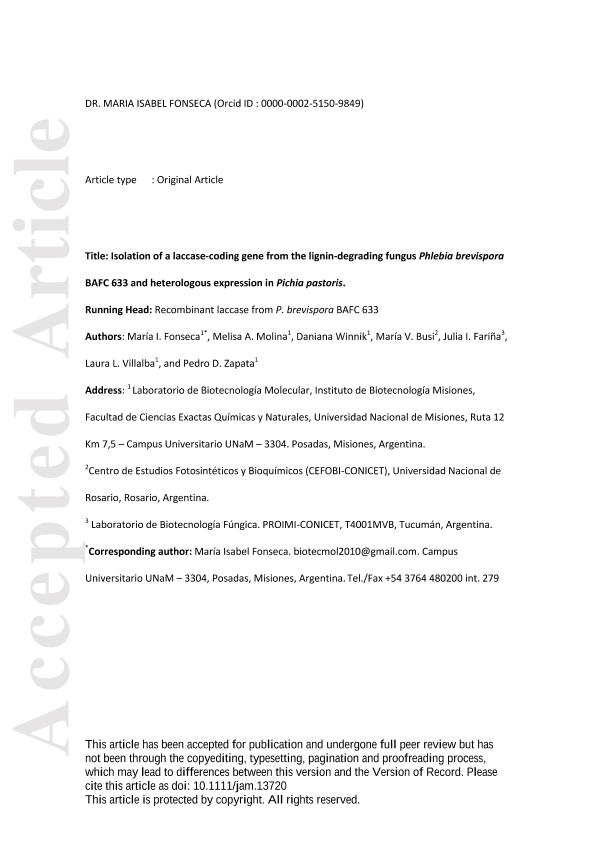Artículo
Isolation of a laccase-coding gene from the lignin-degrading fungus Phlebia brevispora BAFC 633 and heterologous expression in Pichia pastoris
Fonseca, Maria Isabel ; Molina, Melisa Antonella
; Molina, Melisa Antonella ; Winnik, D. L.; Busi, María Victoria
; Winnik, D. L.; Busi, María Victoria ; Fariña, Julia Ines
; Fariña, Julia Ines ; Villalba, Laura; Zapata, Pedro Dario
; Villalba, Laura; Zapata, Pedro Dario
 ; Molina, Melisa Antonella
; Molina, Melisa Antonella ; Winnik, D. L.; Busi, María Victoria
; Winnik, D. L.; Busi, María Victoria ; Fariña, Julia Ines
; Fariña, Julia Ines ; Villalba, Laura; Zapata, Pedro Dario
; Villalba, Laura; Zapata, Pedro Dario
Fecha de publicación:
06/2018
Editorial:
Wiley Blackwell Publishing, Inc
Revista:
Journal of Applied Microbiology
ISSN:
1364-5072
Idioma:
Inglés
Tipo de recurso:
Artículo publicado
Clasificación temática:
Resumen
Aims: Isolate and characterize a laccase-encoding gene (lac I) of Phlebia brevispora BAFC 633, as well as cloning and expressing cDNA of lac I in Pichia pastoris. And to obtain a purified and characterized recombinant laccase to analyse the biotechnological application potential. Methods and Results: Lac I was cloned and sequenced, it contains 2447 pb obtained by PCR and long-distance inverse PCR. Upstream of the structural region of the laccase gene, response elements such as metals, antioxidants, copper, nitrogen and heat shock were found. The coding region consisted of a 1563-pb ORF encoding 521 amino acids. Lac I was functionally expressed in P. pastoris and it was shown that the gene cloned using the α-factor signal peptide was more efficient than the native signal sequence, in directing the secretion of the recombinant protein. Km and highest kcat/Km values towards ABTS, followed by 2,6-dimethylphenol, were similar to other laccases. Lac I showed tolerance to NaCl and solvents, and nine synthetic dyes could be degraded to different degrees. Conclusions: Lac I-encoding gene could be successfully sequenced having cis-acting elements located at the regulatory region. It was found that lac I cDNA expressed in P. pastoris using the α-factor signal peptide was more efficient than the native signal sequence. The purified Lac I exhibited high tolerance towards NaCl and various solvents and degraded some recalcitrant synthetic dyes. Significance and Impact of the Study: The cis-acting elements may be involved in the transcriptional regulation of laccase gene expression. These results may provide a further insight into potential ways of optimizing fermentation process and also open new frontiers for engineering strong promoters for laccase production. The Lac I stability in chloride and solvents and broad decolorization of synthetic dyes are important for its use in organic synthesis work and degradation of dyes from textile effluents respectively.
Archivos asociados
Licencia
Identificadores
Colecciones
Articulos(CCT - NORDESTE)
Articulos de CTRO.CIENTIFICO TECNOL.CONICET - NORDESTE
Articulos de CTRO.CIENTIFICO TECNOL.CONICET - NORDESTE
Articulos(CEFOBI)
Articulos de CENTRO DE EST.FOTOSINTETICOS Y BIOQUIMICOS (I)
Articulos de CENTRO DE EST.FOTOSINTETICOS Y BIOQUIMICOS (I)
Articulos(PROIMI)
Articulos de PLANTA PILOTO DE PROC.IND.MICROBIOLOGICOS (I)
Articulos de PLANTA PILOTO DE PROC.IND.MICROBIOLOGICOS (I)
Citación
Fonseca, Maria Isabel; Molina, Melisa Antonella; Winnik, D. L.; Busi, María Victoria; Fariña, Julia Ines; et al.; Isolation of a laccase-coding gene from the lignin-degrading fungus Phlebia brevispora BAFC 633 and heterologous expression in Pichia pastoris; Wiley Blackwell Publishing, Inc; Journal of Applied Microbiology; 124; 6; 6-2018; 1454-1468
Compartir
Altmétricas



